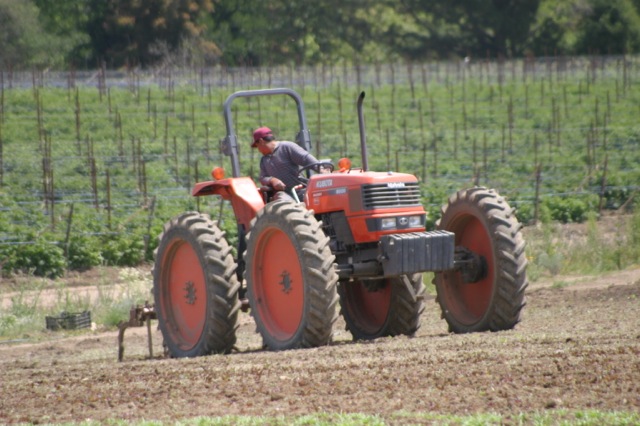 Climate-Friendly Farming at Live Earth Farm
Climate-Friendly Farming at Live Earth Farm
California Climate & Agriculture Network (CalCAN) recently completed a case study on our farm. “You would be hard pressed to find a better model of biodiversity and climate resilience than Live Earth Farm,” was their conclusion. Click here for a PDF of the full profile
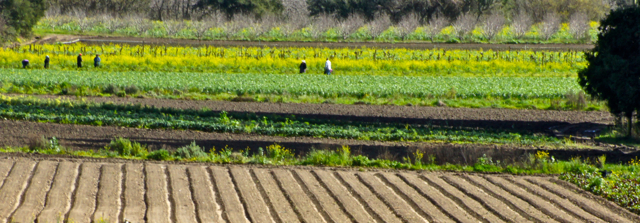
 Relationships make for Healthy Food and Farms
Relationships make for Healthy Food and Farms
Potato seeds (one of my favorite crops) arrive next week, and the “itch” to prepare the soil and plant is returning once again. Tomatoes, peppers, leeks, basil, and a long list of brassicas are on a staggered sowing schedule to ensure a consistent and regular harvest throughout the year. Due to the dry weather many fields are already prepared, allowing us to stay on schedule with all our field sown crops such as sugar snap peas, carrots, turnips, beets, and many of our regular baby greens.
Along with every other farmer in California, I am pondering how to plan, adjust and adapt to the current drought (see last week’s post). As we prepare to face a serious shortage of “life’s elixir”, we become acutely aware of our interdependence with other life-forms. Here on the farm, Water and Food are the sustenance we depend on, the common thread linking all living creatures.
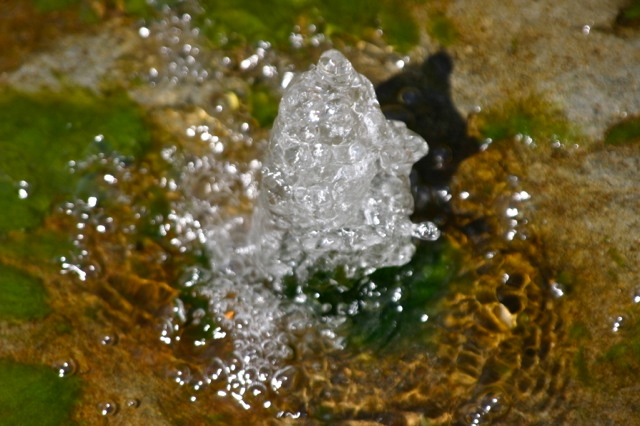
Pumped groundwater arrives at the surface.
Typically, when winter rains are abundant enough there is plenty of water and fresh forage for most of the farm’s wilder cohabitants. However with ponds, creeks, swales, and ditches being dry right now, we need to figure out how we can budget water to support the larger biotic community of wild and domesticated plants and animals on the farm that exist beyond our irrigated field crops.
It may be a coincidence, but I am noticing that wild animals are being attracted to food and water sources closer to our farm dwellings. Last week our neighbor, a few hundred yards up the road, reported the first sighting of a mountain lion, most likely following the deer and wild turkeys roaming close by. I hope this large feline cat is not just curious enough to check out whether our pasture raised chickens, for example, make a tasty alternative in its diet.

A pond near the farm’s upper fields, usually full this time of year, is dry.
The long-term health and resilience of our farm have always been based on the health of its relationships, whether biological, economic, or social, and our approach to farming is to attempt a balanced coexistence between both the domesticated/cultivated and the wilder/native environments. With the current drought, the challenge will be to continue to nurture this relationship. How much water can we afford to maintain for over 10,000 feet of Native Hedgerows recently planted along the edges of our fields, and should we create and maintain strategically placed water supplies for many of the wild animals living in or accessing the farm landscape?
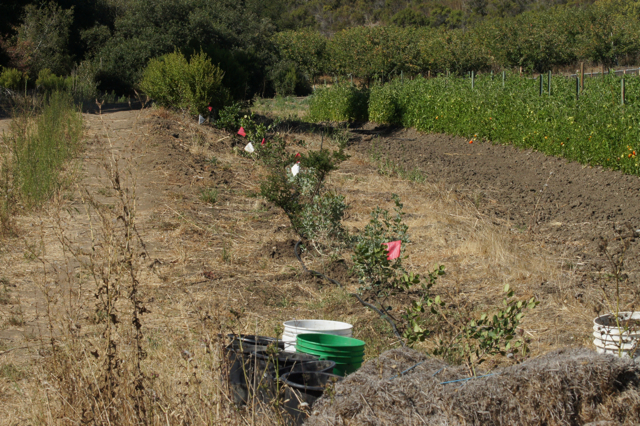
One of the farm’s hedgerow projects.
Live Earth Farm’s CSA members and their relationship with the farm is probably one of the most important. Your individual investment in the farm and your commitment to cook, eat, and enjoy the fruits and vegetables we grow with care and pick fresh for your weekly shares might feel insignificant, but believe me, as a community the combined effect is profound.
It seems early to ask all who have not signed for 2014 to do so soon, yet the farm is starting to gear up for the upcoming Main Season and your CSA membership gives us the necessary certainty to plan ahead. Please contact us if you have any questions, would like to help with outreach or just give us feedback; we look forward to hearing from you.
I invite you all to participate and share the experience of the upcoming Main Season. By becoming a member you will more directly partake in sharing the risk, as well as celebrating the bounty that is inherent in farming.

A field of Brussels sprouts, with rows of mizuna and tatsoi beyond. Espaliered Fuji and Gala apple trees border the right side of the field.
 Community Support = Farm Resilience
Community Support = Farm Resilience
Still no rain! With the long-term forecast looking dry and relatively warm it is with some measure of unease that we are sowing our winter covercrops. Usually the first rains arrive in October and supply enough moisture to ensure good germination. This year we might have to assist with supplemental irrigation to prevent the germinating covercrop from drying up. The lack of rain is a mixed blessing, on one hand it allowed us to enjoy a good growing season, even the most rain susceptible crops such as our Blenheim Apricots and dry-farmed tomatoes were bountiful, on the other hand this prolonged drought causes the overdraft of our finite ground and surface water resources, it has extended the fireseason in our area to more than 7 months, and is stressing native plant and animal life in our surrounding natural environment.

Our local foodsystem depends on an abundant supply of water, almost 80% of the state’s water supply is used for agricultural purposes. At the current rate, more groundwater is being extracted from our Pajaro Valley aquifer than is being replenished; in some cases along the coast, this overdrafting of groundwater is causing saltwater intrusion. We are living on borrowed time as we pump unsustainable amounts of water. With more uncertain weather patterns caused by climate change we are obliged to rethink how to make our farms more resilient and sustainable. Although we can’t change the weather we can certainly prepare and do our part to adapt to the challenges ahead by conserving, diversifying, and using innovative tools to help us adapt and be better prepared for unforeseen circumstances ahead.
As we complete this 18th growing season and prepare once again for the next one, it is gratifying to acknowledge the incredible support that has nurtured this farm since its inception. Every time we plant a seed, it is reassuring to know that the care we invest in the cultivation and development of our crops is backed by the vitality of an entire community: a living network of supporters, everything from the often forgotten soil organisms to the diverse human community of fellow farmers, farm employee’s, farm suppliers, local restaurants, retailers, distributors, CSA members, farmer’s market customers, artisan food producers, cooks, teachers, students, and friends. The food grown on this land becomes a common thread that links us all together, and with every meal we prepare we also enjoy the pleasure and nourishment that comes from it.

This simple but powerful act of taking charge and choosing what goes into our mouths is slowly transforming local and regional food systems. Increasingly more farms across the country are responding by moving away from industrial and destructive growing practices, striving to give consumers both access and choice of more affordable and sustainably grown food.
So it is with heartfelt gratitude that all of us here thank you for supporting and participating in the seasonal journey of Live Earth Farm, and we hope you will stay connected for many more nourishing seasons to come.
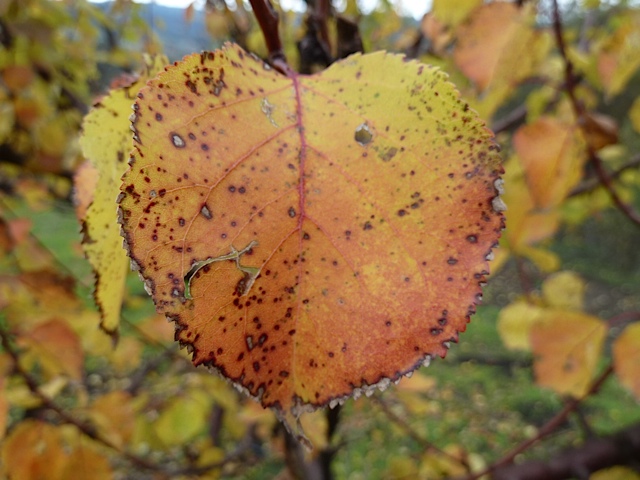
Fall apricot leaf.
We encourage you to stay in touch by reading our winter newsletters, facebook and website updates. We still have a few winter shares left, both the traditional and choice shares, so sign up now, the Winter CSA starts the first week of December. You, the Live Earth Farm CSA members, are the best ambassadors to keep the CSA movement vibrant and successful so don’t hesitate to contact us with feedback, ideas, and suggestions. We like to hear from you.
Of course we always encourage everyone to join us for the many upcoming farm events and celebrations over the course of next season.
Wishing you all a healthy, joyous and peaceful Thanksgiving!

Wild Turkeys meandering in the apple orchard.
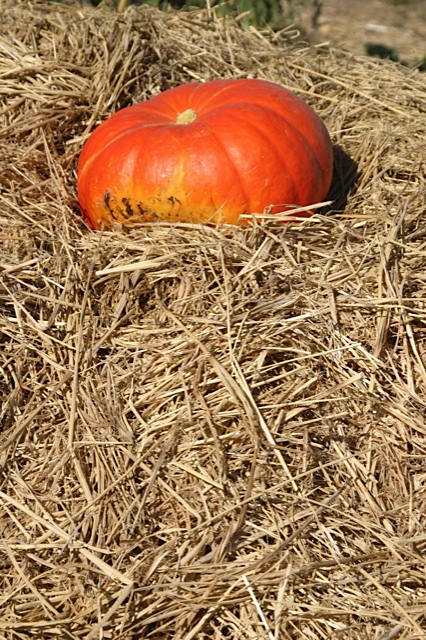
 Farm News & Tom’s Reflections
Farm News & Tom’s Reflections
“…Nature, lying all around, with such beauty and such affection for her children; and yet we are so early weaned from her breast to society, to that culture which is exclusively an interaction of man on man.” - Henry David Thoreau
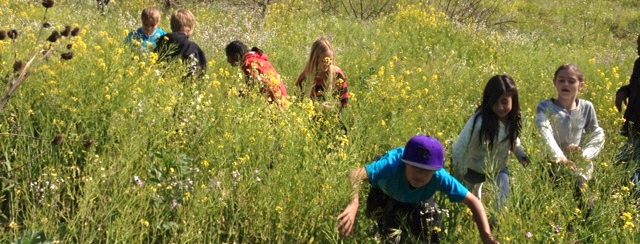
October is here and so are the kids. It’s a popular time of year for local schools to come on field trips exploring and interacting with nature on the farm. Few places can better engage children to experience first hand the many interactive connections and relationships involved in raising plants and animals that eventually become food to keep us alive and healthy.
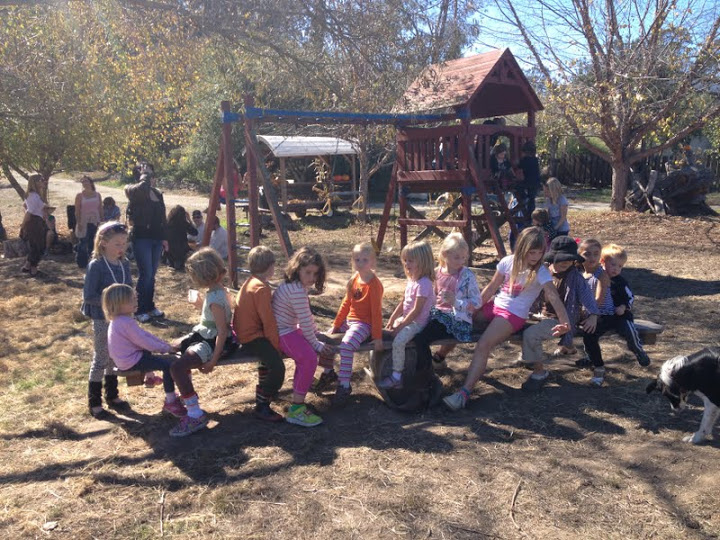 Our farm fields and educational gardens are great teachers; math, physics, biology, and chemistry all come alive through real-life problem solving. How many apples does it take to make a quart of freshly pressed apple cider? Or, how many tomatoes make a pint of salsa? What are the physical and biological building blocks that create a rich fertile organic soil? What are organic alternatives to toxic soil fumigants and pesticides? How does farming affect climate change, water quality and quantity? How has the digital age and today’s information technology revolutionized farming? Kids will learn how their food choices can make a difference in how food is grown on today’s farms.
Our farm fields and educational gardens are great teachers; math, physics, biology, and chemistry all come alive through real-life problem solving. How many apples does it take to make a quart of freshly pressed apple cider? Or, how many tomatoes make a pint of salsa? What are the physical and biological building blocks that create a rich fertile organic soil? What are organic alternatives to toxic soil fumigants and pesticides? How does farming affect climate change, water quality and quantity? How has the digital age and today’s information technology revolutionized farming? Kids will learn how their food choices can make a difference in how food is grown on today’s farms.
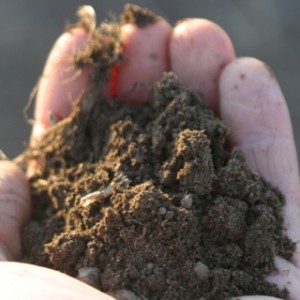 One of the most tangible ways to explain my job is to start with a handful of soil or compost and crumble it between my fingers to explain how as an organic farmer paying close attention to how I nourish the life in soil is essential to growing healthy food. In every teaspoonful there are millions of microorganisms –bacteria, algae, fungi, viruses, mostly invisible to the naked eye all forming intricate webs of interdependence. The “simple” bean for example, has evolved a mutually beneficial relationship with a bacteria that can fix nitrogen and convert into a type of amino acid which the plant turns into proteins, which when consumed will become human proteins. How amazing is that!!!
One of the most tangible ways to explain my job is to start with a handful of soil or compost and crumble it between my fingers to explain how as an organic farmer paying close attention to how I nourish the life in soil is essential to growing healthy food. In every teaspoonful there are millions of microorganisms –bacteria, algae, fungi, viruses, mostly invisible to the naked eye all forming intricate webs of interdependence. The “simple” bean for example, has evolved a mutually beneficial relationship with a bacteria that can fix nitrogen and convert into a type of amino acid which the plant turns into proteins, which when consumed will become human proteins. How amazing is that!!!
The farm is a different kind of classroom where children have the opportunity of using their senses to experience the lifecycles of other living organisms important to support their own – the human life cycle.
We never stop learning from nature, whether it is through the world of insects, the sprouting of a seed unfolding into a delicate seedling, the milking of a cow or simply watching the moon rise over the Santa Cruz Mountains. Nature’s book is a fascinating read and, best of all, we are all in it.
 End of Summer
End of Summer
Not much time to sit down, reflect and write – all our energy is focused on keeping up with the pace and intensity of the farm. It is as if Mother Nature is aware that these are the final weeks of summer. 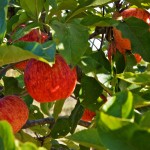 Galas are hanging ripe for the picking. The first block of winter squash (Delicata and Sweet Dumplings) is ready to be harvested. Everything is ripening and there are barely enough hours in the day to keep up with the raspberries, peppers, tomatoes, cucumbers, and summer squash in addition to the usual staple crops of beets, lettuce, broccoli, cauliflower, leeks, and strawberries – to name a few. Now is the time we most feel the support of the team at play, and the smiles on our faces at the end of a 12-13 hour day are a mutual acknowledgement of this joint effort.
Galas are hanging ripe for the picking. The first block of winter squash (Delicata and Sweet Dumplings) is ready to be harvested. Everything is ripening and there are barely enough hours in the day to keep up with the raspberries, peppers, tomatoes, cucumbers, and summer squash in addition to the usual staple crops of beets, lettuce, broccoli, cauliflower, leeks, and strawberries – to name a few. Now is the time we most feel the support of the team at play, and the smiles on our faces at the end of a 12-13 hour day are a mutual acknowledgement of this joint effort.
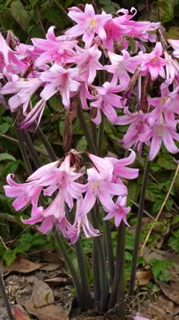 The “Naked Ladies” (Amaryllis belladonna) with their striking pink flowers are in full bloom, which is an early sign that summer is almost over. Knowing that shorter days are just around the corner, we are already preparing the fields and planting our fall and winter crops.
The “Naked Ladies” (Amaryllis belladonna) with their striking pink flowers are in full bloom, which is an early sign that summer is almost over. Knowing that shorter days are just around the corner, we are already preparing the fields and planting our fall and winter crops.
With summer vacations technically over after Labor Day, we invite you to extend that summer feeling a bit longer by joining us for another round of U-pick Community Farm Days the next two Saturdays – August 30th and September 6th.
Bring the kids to explore the farm; we have plenty of activities planned to go along with your harvest adventures – tractor rides, apple cider pressing, and farm walking tours. Now is the best time to pick and preserve the summer bounty to be enjoyed later during fall and winter.
Here on the farm we measure the end of summer when strawberry beds are prepared for planting and we stop picking tomatoes – with the typical extension of our coastal summer weather, the tomato harvest could last into mid-October. Hope to see you here on the farm to join the harvest effort.
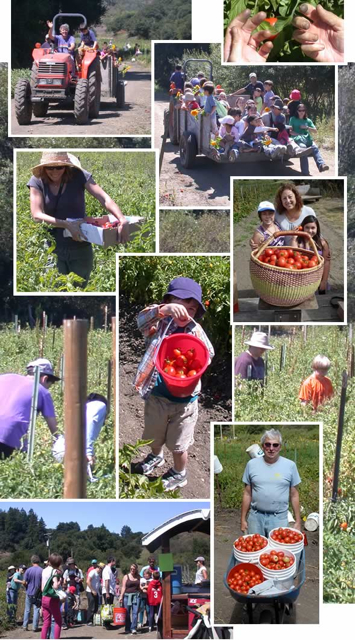
 Little Treasures in Food and Community
Little Treasures in Food and Community
Our three Tomato U-Pick events have been inspiring and fun. An estimated 500 people visited the farm and picked well over 2 tons of tomatoes – that’s an impressive 4,400 pounds. The seasonal abundance was enjoyed by all, as families explored the farm beyond the tomato patch to pick and taste other seasonal favorites such as raspberries, strawberries, apples, cherry tomatoes, tomatillos, and peppers. I personally always enjoy the tractor rides; children are my biggest fans (maybe some adults as well) and this time the added attraction was the apple cider press. After the rides, kids got to experience the crushing and pressing of freshly picked apples into refreshingly sweet cider.
At the end of the day last Saturday, after breaking down the tents and cleaning up, I was surprised to see a small gift bag sitting on the driver’s seat of my truck. Inside, neatly wrapped in silk paper, I found a beautiful assortment of preserves made with farm grown ingredients. I immediately recognized Laurel Parvesi’s (neighbor just down the road from us and longtime farm supporter and CSA member) signature candied orange peel, her jars of berry and plum jam, and tomato sauce. Yes, I will admit, I was teary eyed!!! What a delight! Wow, if that isn’t testimony enough of how easy and fun it is to collaborate as a food-community, between those who produce and those who cook, between those who cook and those who eat (that’s all of us). The taste of something you pick with your hands, perfectly ripe at the peak of its growing season, brought home to the kitchen to turn into tasty creations to share with others, is not just nourishing and flavorful – it’s filled with the taste of love.
Thank you all for coming to enjoy and support “your” farm and its educational programs. We have a few more events planned (Discovery Program Fundraiser, Annual Harvest Festival), and if you just want to swing by for a visit, the best day is Saturday when the Farm Stand is open 10-4. Check out the rest of the newsletter for more details about our upcoming farm events.
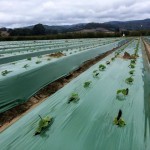 A Pause to be Thankful
A Pause to be Thankful
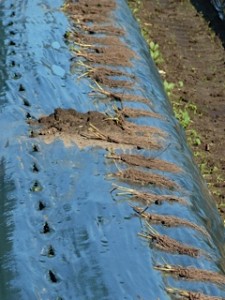
Bare root strawberries waiting to be planted.
We did it! Yesterday, almost all of the 80,000 bare root strawberry plants got planted by late afternoon, beating the arrival of this week’s anticipated rainstorms. All of us felt a sense of relief and well deserved accomplishment now that next season’s strawberry crop is safely planted.
After 20 years of farming, I still get nervous trying to time crop plantings in such a way as to achieve the best set of growing conditions while juggling the demands of so many other farm activities and priorities going on at the same time. This is especially true right now as many preparations are underway with the seasonal transition and the weather becoming more unpredictable.
The challenge of growing food is to continuously improve one’s ability to listen to nature – respecting rather than exploiting the land we farm. We get all caught up in buying and selling things we consider our property, and thinking that ownership is progress and economic growth is the ultimate indicator of well being. In truth we don’t own any of it; we are just guests on this beautiful planet and the crops we grow are but a gift for us to enjoy. It would seem less stressful at times to view ourselves as the ones who belong to the land, instead of living under the false impression that the land belongs to us.
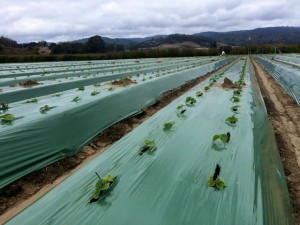
Newly planted strawberries for next Season’s harvest.
As we pause to celebrate Thanksgiving next week, I like to believe that the meals we prepare are more than just food but reflect the common thread that links us together as a community.
The Live Earth Farm team has worked tirelessly to care for and nurture this land, and I am filled with thankfulness for all who contributed to making this another successful season.
We are grateful for your commitment to this farm, and invite you to continue celebrating with us the journey of Live Earth Farm as we start our 20th Growing Season in 2015. Happy Thanksgiving!
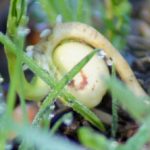 Every Seed Tells a Story
Every Seed Tells a Story
“Though I do not believe that a plant will spring up where no seed has been, I have great faith in a seed. Convince me you have a seed there, and I am prepared to expect wonders.” – Henry David Thoreau, The Dispersion of Seeds.

Warm weather, last weekend’s replenishing rain, and days getting noticeably longer awaken the familiar urgency of Spring. Most of the seeds for the upcoming season’s crops have arrived, and we are once again busy sowing directly into field prepared beds as well as into seedling trays in the more protected greenhouse environment.
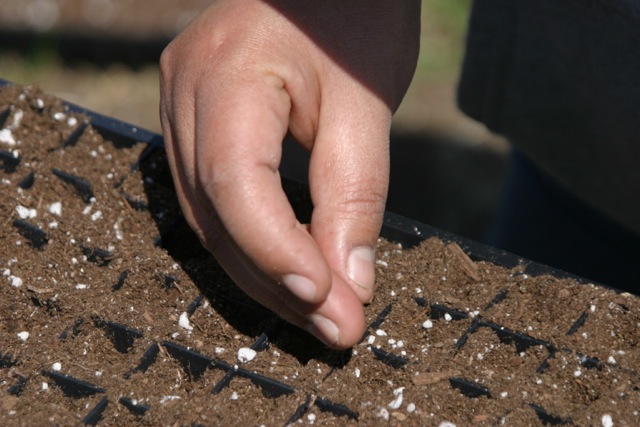
Sowing seeds is an act of faith, and few things are more rewarding than experiencing the life cycle from seed to harvest. As a farmer I see them, of course, as the source of future plants and food, yet they each also contain a fascinating story of culture and history. Each seed encoded with its DNA tells a long, winding, and subtle story. It includes the history of how seeds have crossed human hands, how they have been cultivated, selected, and traded, often shaping the destiny of human civilization and cultures across the world.
For example, our popular dry-farmed Early Girl Tomatoes, sown in mid- January and growing well, trace their ancestry all the way back to wilder relatives in the highlands of Peru where Incas used them for cooking and religious ceremonies. With the Spanish conquistadors tomato seeds got dispersed through the colonies all over the world, and the Early Girl Tomato was bred in France in the 1970’s. When they arrived in the United States they became an instant hit. For us, the Early Girls are the variety of choice since they are one of the very few varieties, if not the only one, that can be dry-farmed; meaning the plants grow on little or no added irrigated water, which gives them their unique, rich, sweet and tangy flavor.
Every vegetable and fruit you get in your CSA share has a story to tell. We all participate in shaping the story of these crops. They become part of our lives as we grow, cook, and eat them. By choosing to eat with the seasons we tune into the story of food grown locally, the history of the land, and the living community we are a part of. It always amazes me to think that the food we enjoy is a gift that manifests through the living stories contained in each tiny seed we plant.
In the spirit of this “earth awakening” Spring weather I invite you to join us to celebrate Live Earth Farm’s still unfolding story now entering it’s 20th Growing Season. Throughout 2015 we will again host many fun-filled farm events and U-Pick days. The first one to kick-off our Spring Season is the Sheep to Shawl Fair on March 21 (Spring Equinox), so mark your calendars and I hope to see you here on the farm soon.
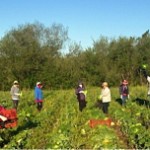 The Hands that Feed Us
The Hands that Feed Us
The long awaited tomatoes are gradually ripening, and as much as we’d like to encourage them to ripen faster the first harvest typically is a teaser and doesn’t yield enough for everyone’s shares.

Get your salt shaker out. Our Early Girl dry-farmed tomatoes are almost ready.
A wave of new crops is at the cusp of maturing, and we like to stagger and rotate their harvests to not feel overwhelmed. Padron peppers need to be harvested every three days to not let them grow much larger than thumb size. Cherry and Early Girl tomatoes will, at first, only need to be harvested every 5-6 days, however a month from now we’ll be picking them everyday to keep up. Currently green beans are abundant, but extremely time consuming to pick.
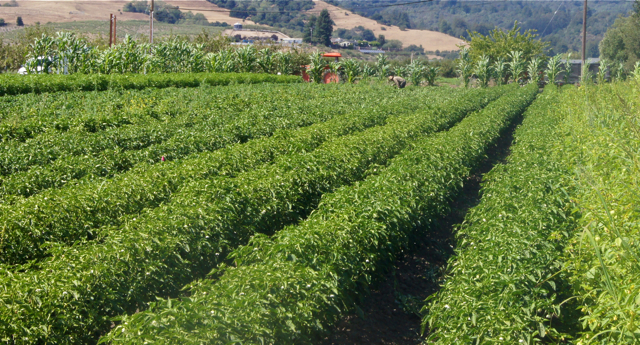
Peppers galore. The Padrons are the taller plants on the far left.

The green beans are sandwiched in between the corn in the foreground and rows of raspberries.
With over 50 crops grown annually, it is important not to over plant to keep harvest schedules manageable. The danger of falling behind is that the quality of the harvest and the health of the plants are compromised. It isn’t easy, many are the variables and priorities we need to juggle, and as we approach the height of summer more crops are being added to the harvest list. Sometimes there just aren’t enough hours and working hands to keep up with Mother Nature.

Some of our field crew harvesting summer squash for Thursday’s shares.

A previous field of summer squash plants is now being prepped for new crops.

Soon the field pictured above will look like this one, with newly formed rows ready for transplants or seeding.
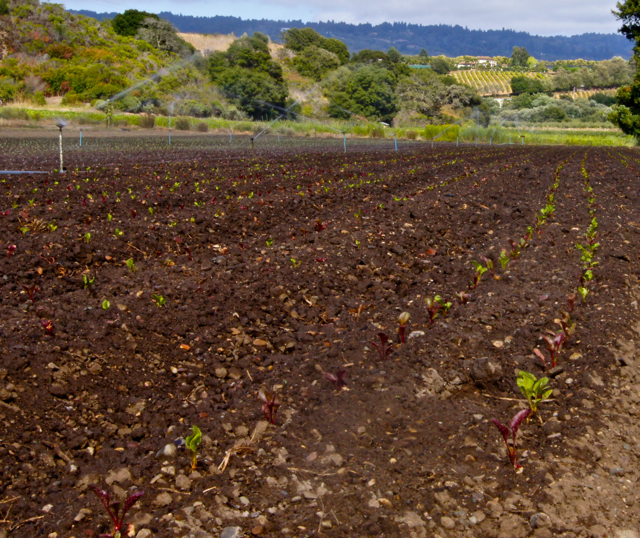
Recent chard transplants being irrigated.

Rows of basil, winter squash, and cucumbers, with the pepper field just beyond.
Last time I took a group of kids on a farm tour I stopped by the carrot patch and showed them how we dig and pull carrots out of the ground then tie them into a bunch with a rubber band. Digging for carrots almost rivals the excitement kids get when picking strawberries. There is something special about tugging on a bunch of leaves not knowing exactly what will appear out of the ground – like going treasure hunting.
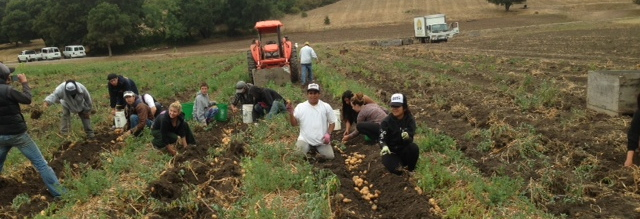
A teen group participating in the potato harvest.
One of the kids asked me almost incredulously, “You dig all these carrots by hand? ” “We sure do, every single one of them”, I confirmed. Although we now have tractors and mechanical tools to help us, small scale organic vegetable and fruit farms like ours rely mostly on hand labor. It is a collective and manual effort – from sowing the seeds, planting, weeding, cultivating, watering, harvesting, washing, packing to finally delivering the shares.

When it comes to working hands on this farm, I can’t think of anyone else than the incredibly dedicated group of people who work tirelessly to make it possible for us to enjoy a sampling of their effort. If your kitchen is anything like ours, a lot of hands will continue in the preparation and cooking of the freshly harvested crops, transforming them into a nourishing meal. To grow healthy food and help create a healthier food-system in our community, all of us can join hands – that’s what it takes!

If you look closely, you may be able to spot the long eared jackrabbit in the midst of the tomatoes.
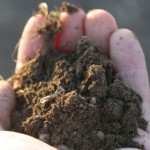 We are all in it together – From the Ground Up!
We are all in it together – From the Ground Up!
The soils that should be saturated from winter rains right now are drying out instead. I notice that the “itch” I get at the beginning of every season to prepare the soil and start planting seems too early. After rejuvenating rains in December, we haven’t seen any precipitation. January should be the wettest month of the year, and it looks like it’s going to be one of our driest. Similar to last year, this worrisome drought has forced us to keep irrigating.
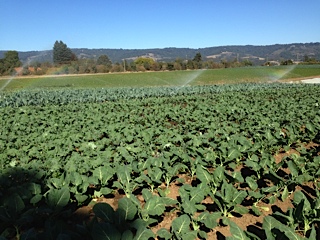
The blue sky is beautiful, yet it means irrigating crops like the ones pictured here is an ongoing necessity.
Along with every other farmer in California, I am pondering how to plan, adjust and adapt to climate change and the continuing drought conditions. With the increasingly unpredictable weather, I look to our soil to help maintain a healthy and resilient farm organism.
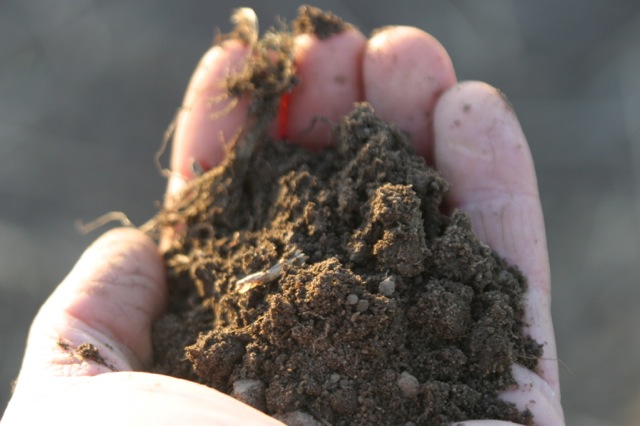
I am convinced that soil and plants hold the key to rebalancing the high CO2 concentrations in the atmosphere. Through photosynthesis plants absorb CO2, turn it into sugars which help them grow and, maybe even more importantly, feed the soil microbes, like bacteria and fungi, in and around the root-zone. These soil microorganisms serve to protect plants and help them access nutrients and minerals that roots by themselves can’t reach. The carbon that was in the air is suddenly transferred back and stored into the soil where it originally came from. There is a direct link between growing nutritious and flavorful fruits and vegetables and nurturing and growing a healthy soil.

The earthworms pictured here are part of a larger soil network that supports the crops growing in the fields.
We mimic natural soil building processes through techniques such as composting, rotating crops and using cover crops, mulching, adding soil amendments, and following careful tillage practices. These techniques allow us to grow and harvest food without depleting but instead returning carbon, fertility, and water holding capacity back to the soil. We still have much to learn yet increasingly we can point to regenerative farming practices that build and improve soil to heal the land and the atmosphere, and at the same time supply us with abundant and healthier food.

A couple of the farm’s compost piles that are almost ready to be spread over the fields.
You and me, we are all stakeholders. We all eat and sit at the same table to figure out this important challenge, maybe the most important – healing our current unsustainable relationship with nature. Our food decisions are meaningful ways to make a difference, whether joining a local farm’s CSA, shopping at the farmer’s market, making locally sourced menu choices at a restaurant, or simply cooking and sharing a meal at home, these are simple but interconnected food solutions that contribute to a healthier local and regional food web.
